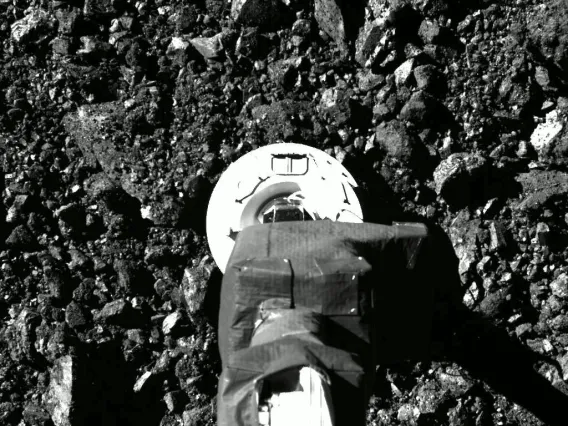
Watch: OSIRIS-REx Touchdown Causes a Stir on Asteroid Bennu
The sampling arm of NASA's OSIRIS-REx spacecraft made contact with asteroid Bennu to stir up surface material and capture some of it for return to Earth in 2023.
Watch: OSIRIS-REx Touchdown Causes a Stir on Asteroid Bennu
×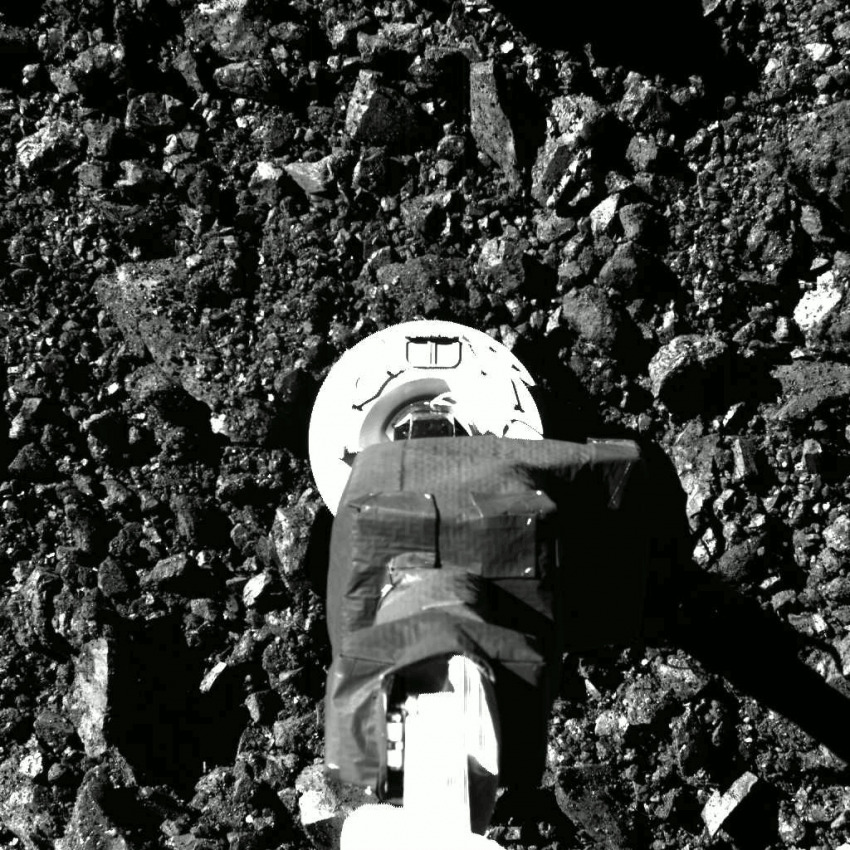
By Daniel Stolte, University Communications - October 22, 2020
With a flick of its "wrist" and a blast from a nitrogen gas bottle, the sampling arm of NASA's OSIRIS-REx spacecraft made contact with asteroid Bennu yesterday to stir up surface material and capture some of it for return to Earth in 2023.
More than 200 million miles from Earth, the spacecraft touched down within 3 feet of the targeted location for about six seconds, then performed a back-away burn.
During the Touch-And-Go, or TAG, sample collection event, the spacecraft's sampling camera, or SamCam, recorded video of the sampling process. Once that footage was downloaded from the spacecraft, scientists at the University of Arizona OSIRIS-REx Science Operations Center went to work to process the footage.
The images were captured over an approximately five-minute period. The imaging sequence begins at about 82 feet above the surface and runs through the back-away maneuver. The sequence was created using 82 SamCam images, with one and a quarter seconds between frames. In the middle of the image sequence, the sampling head can be seen positioning itself on the "wrist" of the sampling arm to contact the asteroid's surface head on.
UArizona's Bashar Rizk, OSIRIS-REx camera suite instrument scientist, said the SamCam TAG image sequence – acquired just before, during and after sampling – is "simply remarkable."
"The TAGSAM arm and head plunged into the surface of Bennu and seemed to crush a small boulder, as if it were made of chocolate," he said. "When the nitrogen gas released, it created a cloud of particles so thick that it blocked the sunlight from the neighborhood of the Nightingale sampling site."
The mission's image processing team is now anxiously awaiting the first peek into the sampling head to get an idea what type of material and how much was captured during the TAG event. While the spacecraft has backed away to a safe distance from Bennu's surface, it will maneuver and tilt the sampling head into various positions while SamCam takes pictures. The mission team will also measure the amount of material collected through various spacecraft activities, such as a "pirouette" in space.
Media can access videos and GIFs at https://arizona.box.com/v/OsirisRExTAG-FirstImages.
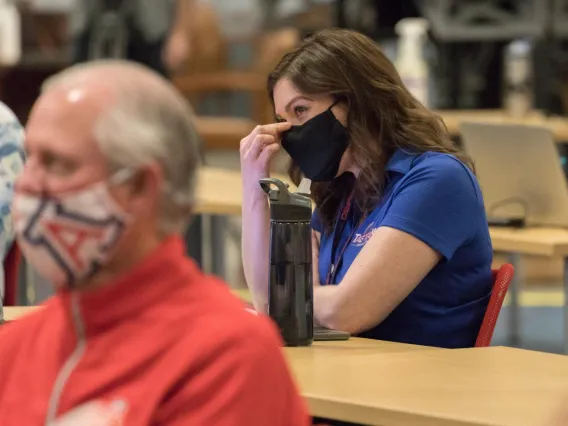
UArizona Mission Members Celebrate OSIRIS-REx Success
Members of the LPL-led OSIRIS-REx mission, along with UArizona leadership, gathered to watch NASA's live broadcast of the mission's much-anticipated Touch-and-Go, or TAG, sampling event.
UArizona Mission Members Celebrate OSIRIS-REx Success
×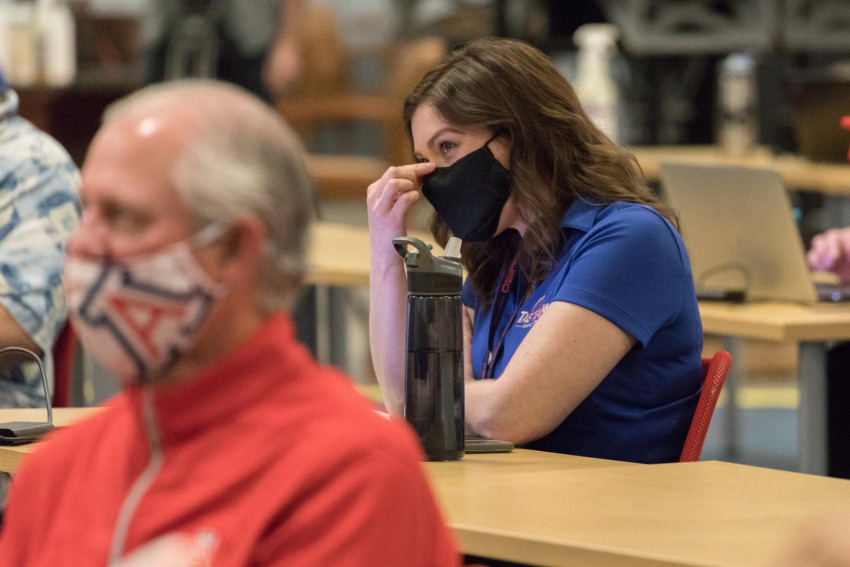
By Daniel Stolte, University Communications - October 20, 2020
If NASA's OSIRIS-REx spacecraft could talk, today it might have said, "Finally!"
At 10:50 a.m. Tucson time, the van-sized spacecraft fired its thrusters to leave the safe-home orbit around asteroid Bennu and began descending toward the asteroid's surface, which the spacecraft spent two years photographing and mapping in tremendous detail. Its mission: Touch the asteroid for a few seconds and collect a sample to be later brought back to Earth.
Members of the University of Arizona-led OSIRIS-REx mission, along with UArizona leadership, gathered at the university's Michael J. Drake Building, where the mission is headquartered, to watch NASA's live broadcast of the mission's much-anticipated Touch-and-Go, or TAG, event and listen to status updates from the spacecraft.
At 3:13 p.m. Tucson time, the atmosphere inside the building changed from one of subdued anticipation to elation and relief as a physically distanced, masked crowd started to clap and cheer.
At that time, the mission's spacecraft confirmed that it had touched the surface of asteroid Bennu for 4.7 seconds and triggered a flush of nitrogen gas with the goal of collecting the largest sample of extraterrestrial material since the Apollo moon landings.
"I can't believe we pulled this off," Dante Lauretta, principal investigator of the OSIRIS-REx mission and a UArizona professor of planetary sciences, said from the mission control room at Lockheed Martin in Denver, where NASA's broadcast was based. "This is history. This is amazing."
Shortly after touching Bennu, the spacecraft communicated that it had backed safely away from the asteroid to return into orbit and await the next phase of the mission, in which the team will pore over images taken by the spacecraft's onboard sampling camera and perform a series of measurements and maneuvers to assess whether the sampling process was successful and how much material was collected. According to the data available to the mission team immediately after TAG, the spacecraft had touched down with amazing precision – less than three feet from its target site, according to Lauretta.
"We couldn't have asked for a better outcome," he said. "The spacecraft did everything it was supposed to do. It's up to Bennu now to see how the event went."
Collecting a sample from Bennu involved what essentially amounted to parallel parking a 15-passenger van and dodging hazards including a boulder as tall as a two-story building – all 200 million miles away from Earth. Because of the time delay between Bennu and Earth, the spacecraft had been programmed to steer itself during the entire sequence.
"We spent many late nights and weekends writing commands to go up to our instruments, so it's exciting to see them execute flawlessly," said Sara Knutson, the mission's science operations lead engineer, who watched the broadcast from the Drake Building in Tucson.
"I was definitely holding my breath today," said OSIRIS-REx image processing lead scientist Daniella DellaGiustina, who was also at Drake. "But what stands out to me is just how much according to plan everything went, and that has been a standard on this mission. The fact that we have been so spot on with every first-time event on this mission is a testament to the incredible engineering and scientific efforts of so many people that have worked tirelessly to make this happen."
"This kind of fundamental discovery and the research opportunities it creates make the University of Arizona the premier institution that it is," said UArizona President Robert C. Robbins, who joined the mission members at the Drake Building. "This work fulfills something at the core of who we are as a species, and as an institution, and you should all be very proud of what you've accomplished."
Elizabeth "Betsy" Cantwell, UArizona senior vice president for research and innovation, who has a long career in space systems engineering, praised the team's work with complex engineering.
"Massive kudos to the systems engineers who made this miracle happen. ... It is incredible that we have people like that here to support the science," she said.
While TAG was the most critical moment of the entire mission, the OSIRIS-REx team members will barely have time to catch their breath. The coming days will be spent analyzing images taken during the event and recreating the descent trajectory to get an idea of where exactly the spacecraft tagged the surface, which will provide clues to the quality and quantity of the sample that may have been caught in the spacecraft's sampling head.
"OSIRIS-REx is kind of like a relay race," said Carl Hergenrother, OSIRIS-REx lead astronomer. "First, you get the proposal; then, you have the people who build the spacecraft and the instruments, then the people who planned the mission, made the observations to study the asteroid up close; and now, the mission isn't over. We're just handing off the baton to the next leg – to the people who are going to study the samples on the ground and really learn what really is the goal of the mission: the history of the solar system."
EXTRA INFO
For the latest news on the OSIRIS-REx mission, visit news.arizona.edu/news/osirisrex.
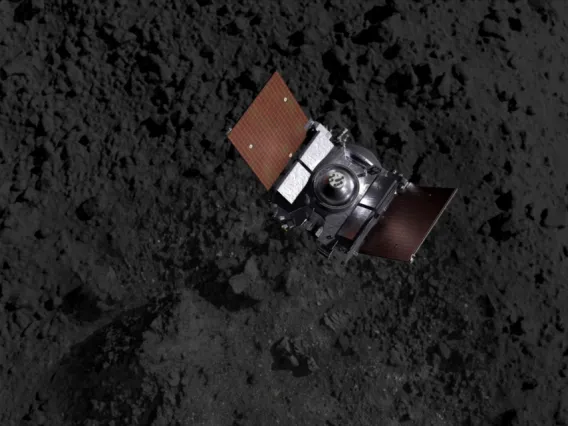
OSIRIS-REx Successfully Touches Asteroid Bennu in Sample Grab
Ten years after NASA selected LPL to lead the OSIRIS-REx mission, the spacecraft successfully completed its most treacherous and rewarding task: sample collection.
OSIRIS-REx Successfully Touches Asteroid Bennu in Sample Grab
×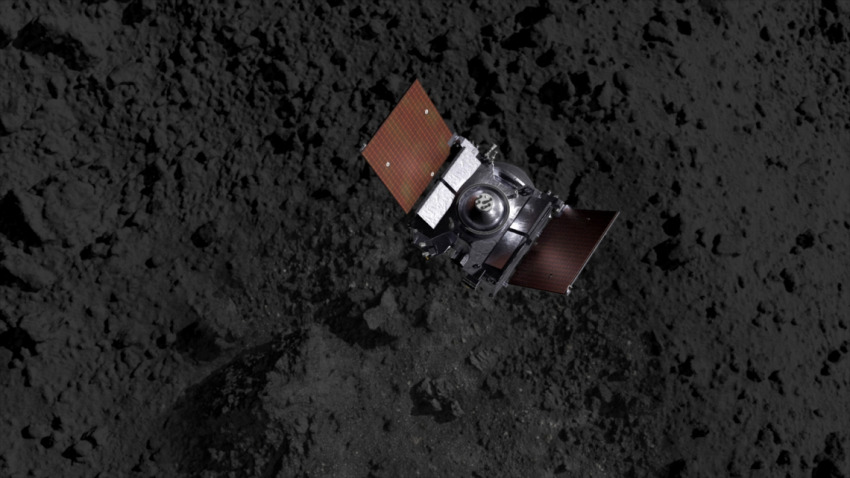
NASA Goddard Space Flight Center and University Communications - October 20, 2020
NASA's OSIRIS-REx spacecraft unfurled its robotic arm today, and in a first for the agency, briefly touched an asteroid in an attempt to collect dust and pebbles from the surface for delivery to Earth in 2023.
"After over a decade of planning, the team is overjoyed at the success of today’s sampling attempt," said Dante Lauretta, OSIRIS-REx principal investigator and a professor of planetary sciences at the University of Arizona. "Even though we have some work ahead of us to determine the outcome of the event – the successful contact, the TAGSAM (Touch-and-Go Sample Acquisition Mechanism) gas firing and back-away from Bennu are major accomplishments for the team. I look forward to analyzing the data to determine the mass of sample collected."
The well-preserved, ancient asteroid, known as Bennu, is currently more than 200 million miles from Earth. Bennu offers scientists a window into the early solar system as it was first taking shape billions of years ago and flinging ingredients that could have helped seed life on Earth. If today’s contact with the surface provided enough of a sample, teams will command the spacecraft to begin stowing the precious primordial cargo to begin its journey to Earth in March 2021. Otherwise, they will prepare for another attempt in January.
"This amazing first for NASA demonstrates how an incredible team from across the country came together and persevered through incredible challenges to expand the boundaries of knowledge," said NASA Administrator Jim Bridenstine. "Our industry, academic and international partners have made it possible to hold a piece of the most ancient solar system in our hands."
At 10:50 a.m. Tucson time on Oct. 20, the OSIRIS-REx spacecraft fired its thrusters to nudge itself out of orbit around Bennu. It extended the shoulder, then elbow, then wrist of its 11-foot sampling arm, known as the Touch-and-Go Sample Acquisition Mechanism, or TAGSAM, and transited across Bennu while descending about half a mile toward the surface. After a four-hour descent, at an altitude of approximately 410 feet, the spacecraft executed the "Checkpoint" burn, the first of two maneuvers to allow it to precisely target the sample collection site called Nightingale.
Ten minutes later, the spacecraft fired its thrusters for the second "Matchpoint" burn to slow its descent and match the asteroid's rotation at the time of contact. It then continued on a treacherous, 11-minute coast past a boulder the size of a two-story building, nicknamed "Mount Doom," to touch down in a clear spot in a crater on Bennu's northern hemisphere. The size of a small parking lot, site Nightingale is one of the few relatively clear spots on this unexpectedly boulder-covered space rock.
"This was an incredible feat – and today we've advanced both science and engineering and our prospects for future missions to study these mysterious ancient storytellers of the solar system," said Thomas Zurbuchen, associate administrator for NASA's Science Mission Directorate at the agency's headquarters in Washington, D.C. "A piece of primordial rock that has witnessed our solar system's entire history may now be ready to come home for generations of scientific discovery, and we can’t wait to see what comes next."
Next Steps
All spacecraft telemetry indicates that today's sample collection event, known as TAG, which stands for Touch-and-Go, executed as expected. However, it will take about a week for the OSIRIS-REx team to confirm how much sample the spacecraft collected.
Real-time data indicates the TAGSAM successfully contacted the surface and fired a burst of nitrogen gas. The gas should have stirred up dust and pebbles on Bennu's surface, some of which should have been captured in the TAGSAM sample collection head. OSIRIS-REx engineers also confirmed that shortly after the spacecraft made contact with the surface it fired its thrusters and safely backed away from Bennu.
"Today's TAG maneuver was historic," said Lori Glaze, Planetary Science Division director at NASA Headquarters in Washington, D.C. "The fact that we safely and successfully touched the surface of Bennu, in addition to all the other milestones this mission has already achieved, is a testament to the living spirit of exploration that continues to uncover the secrets of the solar system."
"It's hard to put into words how exciting it was to receive confirmation that the spacecraft successfully touched the surface and fired one of the gas bottles," said Michael Moreau, OSIRIS-REx deputy project manager at NASA's Goddard Space Flight Center in Greenbelt, Maryland. "The team can't wait to receive the imagery from the TAG event late tonight and see how the surface of Bennu responded to the TAG event."
The spacecraft carried out TAG autonomously, with pre-programmed instructions from engineers on Earth. Now, the OSIRIS-REx team will begin to assess whether the spacecraft grabbed any material, and, if so, how much; the goal is at least 60 grams, which is roughly equivalent to a full-sized candy bar.
OSIRIS-REx engineers and scientists will use several clever techniques to identify and measure the sample remotely. First, they'll compare images of the Nightingale site before and after TAG to see how much surface material moved around in response to the burst of gas.
"Our first indication of whether we were successful in collecting a sample will come on Oct. 21 when we downlink the back-away movie from the spacecraft," Moreau said. "If TAG made a significant disturbance of the surface, we likely collected a lot of material."
Next, the team will try to determine the amount of sample collected. One method involves taking pictures of the TAGSAM head with a camera known as SamCam, which is devoted to documenting the sample-collection process and determining whether dust and rocks made it into the collector head. One indirect indication will be the amount of dust found around the sample collector head. But OSIRIS-REx engineers will also attempt to snap photos that could show the inside of the head, given the right lighting conditions, so engineers can look for evidence of sample inside of it.
A couple of days after the SamCam images are analyzed, the spacecraft will attempt yet another method to measure the mass of the sample collected by determining the change in the spacecraft's "moment of inertia," a phrase that describes how mass is distributed and how it affects the rotation of the body around a central axis. This maneuver entails extending the TAGSAM arm out to the side of the spacecraft and slowly spinning the spacecraft about an axis perpendicular to the arm. This technique is analogous to a person spinning with their arm extended while holding a string with a ball attached to the end; the person can sense the mass of the ball by the tension in the string. Having done this maneuver before TAG, and now after, engineers can measure the change in the mass of the collection head as a result of the sample inside.
"We will use the combination of data from TAG and the post-TAG images and mass measurement to assess our confidence that we have collected at least 60 grams of sample," said Rich Burns, OSIRIS-REx project manager at Goddard. "If our confidence is high, we'll make the decision to stow the sample on Oct. 30."
To store the sample, engineers will command the robotic arm to place the sample collector head into the Sample Return Capsule located in the body of the spacecraft. The sample arm will then retract to the side of the spacecraft for the final time, the Sample Return Capsule will close, and the spacecraft will prepare for its departure from Bennu in March 2021 — this is the next time Bennu will be properly aligned with Earth for the most fuel-efficient return flight.
If, however, it turns out that the spacecraft did not collect enough sample at Nightingale, it will attempt another TAG on Jan. 12, 2021. Next time, it'll touch down at the back-up site called Osprey, which is another relatively boulder-free area inside a crater near Bennu’s equator.
NASA's University of Arizona-led OSIRIS-REx mission, which stands for Origins, Spectral Interpretation, Resource Identification, Security-Regolith Explorer, launched from the Cape Canaveral Air Force Station in Florida on Sept. 8, 2016. It arrived at Bennu on Dec. 3, 2018, and began orbiting the asteroid for the first time on Dec. 31, 2018. The spacecraft is scheduled to return to Earth on Sept. 24, 2023, when it will parachute the Sample Return Capsule into Utah's west desert where scientists will be waiting to collect it.
Goddard provides overall mission management, systems engineering and the safety and mission assurance for OSIRIS-REx. Lauretta of the University of Arizona is the principal investigator, and UArizona also leads the science team and the mission's science observation planning and data processing. Lockheed Martin Space in Denver built the spacecraft and is providing flight operations. Goddard and KinetX Aerospace are responsible for navigating the OSIRIS-REx spacecraft. OSIRIS-REx is the third mission in NASA's New Frontiers Program, which is managed by NASA's Marshall Space Flight Center in Huntsville, Alabama for the agency's Science Mission Directorate in Washington.
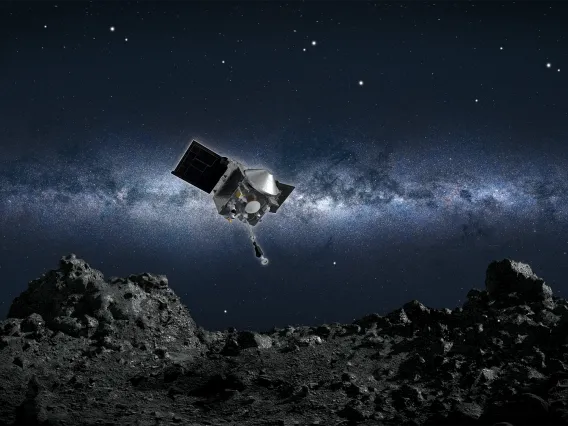
What Touching an Asteroid Can Teach Us
NASA will make history on Oct. 20 by attempting its first-ever sample collection maneuver at an asteroid. LPL professor Dante Lauretta, principal investigator for the OSIRIS-REx mission, discusses the significance of the mission for science and society.
What Touching an Asteroid Can Teach Us
×
By Mikayla Mace, University of Arizona - October 19, 2020
The University of Arizona-led OSIRIS-REx mission will make NASA's first attempt at collecting a sample from an asteroid on Oct. 20. The sample, which will be returned to Earth in 2023, has the potential to shed light on the origins of life and the solar system.
NASA's UArizona-led OSIRIS-REx mission is the agency's first attempt to bring back a sample from an asteroid.NASA
As the spacecraft prepares for its Touch-and-Go, or TAG, maneuver at asteroid Bennu, UArizona News spoke with Dante Lauretta, the mission's principal investigator and a professor of planetary science at the UArizona Lunar and Planetary Laboratory, about the significance of the mission and it impact on science and society.
Q: We often hear that the mission will shed light on the origins of life and the solar system, but how will it do that?
A: Bennu is a fragment from the earliest stages of solar system formation. It escaped the fate of so many other asteroids by not becoming a piece of a planet. Earth itself formed from asteroids like Bennu; Bennu just happened to survive that process. So, Bennu is like a fossil from a time in the solar system before life or Earth even formed.
Since life as we know it is made from DNA, we want to know if the building blocks of DNA are on Bennu. If the building blocks that make up DNA formed early in the solar system and were preserved in carbon-rich asteroids, then they could have been delivered to Earth, Mars, Europa, Titan and all these other places we're looking for life. It would mean the seeds of life were not unique to the Earth, so our search for life in the solar system gets more exciting.
If we don't find them on Bennu, it might mean that those life-seeding molecules had to form in Earth's early environment.
Also, we think water plays a key role in that life-forming chemistry. For example, advanced life first took hold in the oceans before moving to land, and we now know that Bennu is a water-rich asteroid. So, we think that the water that made Earth habitable came from asteroids like Bennu. If that's the case, then other planets, like Mars and definitely the icy worlds in the outer solar system, can trace their water linage and organic chemistry in the same way.
Q: One thing I hear a lot about is how pristine these samples will be. Why is that so important? Am I wrong in thinking that just because you burnt the pancake doesn't mean you can't scrape it off and eat it?
A: We have hints at the chemistry of the early solar system from meteorites, which are fragments of asteroids that land on Earth. The problem is that they are immediately contaminated: Bacteria crawl on them and eat the carbon-rich meteorites; people handle them and don't collect them in the cleanest way in the field. So, it's not just burning the pancake; it's like mixing dirt into the batter once it's on the surface.
So, when we say "pristine," we are removing that level of contamination from the problem. I like to compare it to a forensic investigation; you're trying to convince the jury in a court of law that this DNA was from a crime scene, but if that evidence wasn't in your control that entire time, the defense would say it could have been contaminated and you can't link to the crime scene. In our case, if we want to say the organic molecules from the sample came from the asteroid and aren't contaminants, then we have to control the full chain of history, from asteroid to sample return capsule to lab.
Q: What are you expecting to find in these samples that we haven't already found in meteorites that fall to Earth?
A: A bunch of our new published research is finding that the rocks on Bennu look different than meteorites in a couple of ways. Bennu's rocks are actually really weak, unlike meteorites found on Earth that you have to whack with hammer. Only the strongest fragments survive the fall to Earth, so what we collect from Bennu will be the material that would have likely burned up on entry. Back to the pancake analogy: The pancake could have had caramel glaze that went up in smoke and you wouldn't know. We're hoping to find something more delicate and fragile that's not in the meteorite collection.
Another really exciting thing we found are these veins of carbonate minerals – the white stuff that forms around faucets – on Bennu. These are like a meter long and tens of centimeters thick. We do find them in meteorites but they're tiny, like strands of hair. This material forms by the precipitation by hot water, similar to when a tea kettle boils water off and leaves behind white crud at the bottom. That white crud was dissolved minerals, like what we found on Bennu. If we can get these back in a sample, we speculate – and hope – that we might find pockets of water trapped inside. In any case, we'll have a detailed record of the chemistry of water on Bennu.
Q: This all touches on why sampling Bennu is important for science, but why is this important for society?
A: There are two big reasons. The first is that Bennu is a potentially hazardous asteroid. Pre-launch analysis showed that there was a 1 in 2,700 chance that Bennu will impact Earth in 150 years. It's still a low-likelihood event, but it's of big enough consequence that we should be mitigating and characterizing the risk. By 2135, when Bennu makes its next close approach between the Earth and the moon, we will be able to confirm that it won't hit. Should any asteroid pose an impact threat to Earth, data about the asteroid, like the data we've collected at Bennu, would be valuable to prepare. We've set the standard for characterizing the properties of an asteroid. This is like our gift to the future.
The second is the asteroid mining angle. The No. 1 commodity is water. You can break it into liquid oxygen and hydrogen to make rocket fuel. We've proven the value of Bennu as an ore deposit and water resource, and Bennu is very accessible from the Earth. It could eventually become a gas station in space.
Q: What is most exciting to you about the mission?
A: Sample science is my background, so I'm most excited to be transitioning to the sample science phase of the mission. Now, I get to think about all the fun things we're going to do with the sample once it's back on Earth and partnering with labs all over the world. I think of this as the third science campaign of OSIRIS-REx: The first was astronomy, where we determined its size, shape and orbital path. Then, we arrived and began remote sensing; the recent six papers are culmination of that work. Now, we're in the sample science phase. So, from telescope to spacecraft to microscope, it's a cool arch, scientifically and career-wise, to go through.
I'm also excited to think about what's next. I'm still three years out from sample return, but I'm starting to think about what I might do after OSIRIS-REx. I haven't had that thought for 20 years.
And, lastly, I'm excited to inspire the next generation, and I think we really nailed that. I'm proud of the students who grew up in this program. Some have even been hired on after graduation. And there's a lot of value to the education of school-age kids following along with this mission.
EXTRA INFO
NASA will provide live coverage of the Touch-and-Go, or TAG, event starting at 2 p.m. (PT) on Oct. 20, with sample collection schedule for 3:12 p.m. (PT). Viewers can tune in at https://www.nasa.gov/nasalive.
Hosted by Dante Lauretta, the mission's principal investigator and UArizona professor of lunar and planetary sciences, and Michelle Thaller, science communicator at NASA's Goddard Space Flight Center, the broadcast will cover milestones in the 90 minutes leading up to TAG and spacecraft back-away.
For the latest news on the OSIRIS-REx mission, visit news.arizona.edu/news/osirisrex.
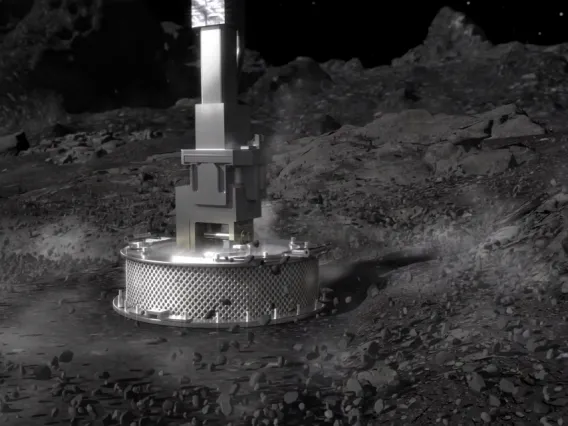
Why Scooping a Sample from an Asteroid is Harder than it Looks
Here's what will happen on Oct. 20, when NASA's OSIRIS-REx spacecraft will descend to asteroid Bennu and pick up a sample of pristine material left over from the formation of our solar system.
Why Scooping a Sample from an Asteroid is Harder than it Looks
×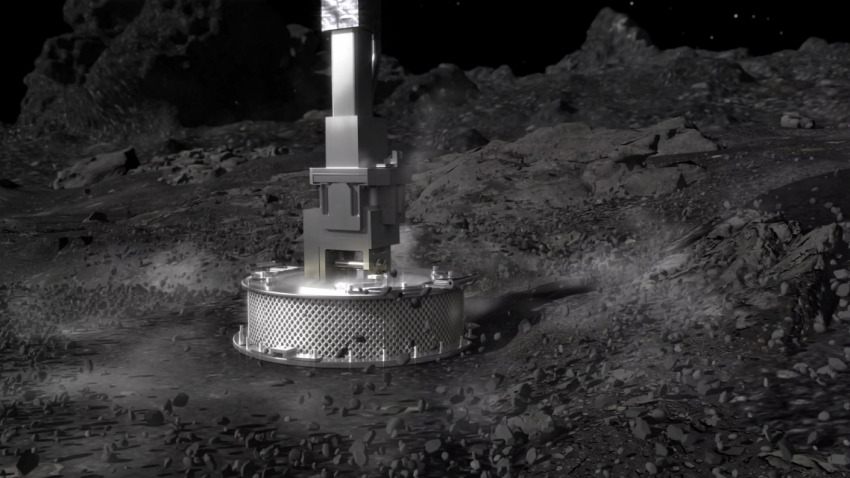
By Daniel Stolte, University Communications - October 15, 2020
When NASA's OSIRIS-REx spacecraft descends toward the surface of Bennu on Oct. 20, it will be the first time that a U.S.-led mission attempts to pick up a sample of pristine material from an asteroid. Bennu is likely an extraterrestrial accumulation of the original leftovers from the formation of our solar system.
The University of Arizona-led mission to sample an asteroid many millions of miles from Earth is anything but a walk on the beach. As a matter of fact, Bennu "is not nearly the sandy beach we hoped and were expecting," said Thomas Zurbuchen, associate administrator for the Science Mission Directorate at NASA, during a Sept. 24 media event. Once the spacecraft moved closer and began sending back the first detailed images of Bennu's surface, it surprised the mission team and the public alike by revealing a rocky surface littered with house-sized boulders.
Since its arrival on Dec. 3, 2018, the OSIRIS-REx spacecraft has spent its time flying around the asteroid while scanning, photographing, measuring and studying the dark, rocky rubble pile below – from afar at first, then up close. Using its laser altimeter instrument, or OLA, combined with the data from images taken with the spacecraft's PolyCam instrument, the mission has produced maps of unprecedented detail, better than those of any planetary body visited by spacecraft. The mission's primary sample site, which sits inside a crater dubbed Nightingale, was selected based on those maps.
"We selected Nightingale because, by far, it has the most fine-grained material of all the four sample site candidates," said Dante Lauretta, the mission's principal investigator and a professor at the UArizona Lunar and Planetary Laboratory, during the press event. "We spent early 2020 doing low-altitude reconnaissance passes over this site, ultimately imaging at about an eighth of an inch per pixel. We basically have incredibly detailed images covering the entire crater, and we counted all of those rocks."
Shortly before 11 a.m. Arizona time on Oct. 20, thrusters on the spacecraft will fire and gently nudge OSIRIS-REx out of its orbit around Bennu and steer it down toward the rugged surface. That burn will set in motion a sequence of events that has been planned meticulously by the mission team.
What Happens if Everything Goes as Planned? And if it Doesn't?
Once the spacecraft has set off on the descent to its target, it will rely on what the mission team calls a "hazard map" – a detailed representation of areas within the sample site that may present a risk to the spacecraft due to the presence of large rocks or uneven terrain.
Just prior to touching the surface, the spacecraft will compare images from one of its cameras with the hazard map stored in the spacecraft's memory. If the descent path would result in the spacecraft touching down in a potentially unsafe spot, the system would automatically trigger the spacecraft to back away, a scenario that has a probability of less than 6% based on simulations.
If everything goes well, the spacecraft will extend its Touch-and-Go Sample Acquisition Mechanism, or TAGSAM, which is suspended at the tip of an 11-feet-long arm. Reminiscent of an air filter used in an older car, it is designed to collect fine grained material, but is capable of ingesting material up to about three quarters of an inch.
The sample will be collected during a "touch-and-go" maneuver, or TAG, during which the sampling head will make contact with Bennu's surface for around 10 seconds. When the spacecraft detects contact, it will fire one of three nitrogen gas bottles, and much like a reverse vacuum cleaner, stir up surface material – called regolith – inside the sampler head, before the spacecraft backs away.
As a backup, the sampling head features a series of small discs designed to pick up dust like sticky pads, in case something were to go wrong with the gas-powered sampling process.
The team will examine footage taken by the spacecraft's sampling camera, or SamCam, of the sampling head as it makes contact with the surface. SamCam is one of three cameras aboard the spacecraft that were built at UArizona.
"We'll be able to tell if we were tilted, if gas blew out to the side, if material was sufficiently stirred up," Lauretta said. "We also will have a very good indication of the exact location in Nightingale where we made contact and we can compare that to our samplability map, to assess if we touched down in an area where there is abundant samplable material or one of the rockier locations."
SamCam also will be able to take images of the sampling head after the spacecraft has departed Nightingale crater and is a safe distance from the asteroid. Because the sampling head is mounted on a wrist joint, the team will be able to examine it at a different orientations relative to the sun and the sampling camera. The team also will see any dust or material on any other area of the TAGSAM, on the arm or on the blanketing over the gas bottles, Lauretta explained.
"This will tell us whether we moved enough material around when we made contact, and maybe, just maybe, we'll be able to see some of the particles in the interior of TAGSAM, if the particles are in the right location inside the head and if we get the right illumination conditions."
After TAG, the team will then spend one week assessing how much sample was collected. It will use several methods to estimate the amount of sample, beginning with imaging the sample collection head for visual inspection. The team will also be performing checkouts of the spacecraft and instruments to verify that didn't result in degradation to either.
A Pirouette in Space
Next, the spacecraft is prepared to perform a maneuver designed to give the scientists on the ground an estimate of how much sample was collected. With its sampling arm extended, it will slowly spin around an axis perpendicular to TAGSAM to measure the change in mass attributable to the collected sample by comparison to a previous measurement taken with the sampling head empty.
Due to uncertainty in the technique, the result of the measurement needs to exceed the required sample mass to have high confidence that an adequate sample is present.
"We'll be looking for a 90% chance that we have 60 actual grams or more," Lauretta said. "Anything below that, we'll have conversations with NASA to assess the status of the spacecraft, its ability to go in for a second TAG, and to decide whether we want to return with what we have or go for a second TAG attempt."
The spacecraft can make multiple sampling attempts, as it is equipped with three bottles of nitrogen gas. For example, if it were to touch down in a safe location but failed to come up with a good sample, the team has developed contingency measures to ensure the mission still meets its primary science objective: collect at least 60 grams (just under 2 ounces) of surface material and return it to Earth.
"In case the decision is made we need to go in again, we have to get the spacecraft back into orbit and conduct a series of burns to line up its position in orbit for the next tag attempt," said Mike Moreau, deputy project manager at NASA's Goddard Space Flight Center in Maryland.
While Nightingale was identified as the best place to get a sample on all of Bennu, it still presents a lot of challenges, Lauretta said.
"By far, the most likely outcome we will have on Oct. 20 is we will contact the surface and came away with a large sample that exceeds our requirements. But Bennu has thrown us a number of curve balls already, which is why we are fully prepared to tag at Osprey (the backup site) if that becomes necessary," he said.
Once the decision is made to stow the sample, the team will proceed to place the head inside the sample return capsule and seal it for return to Earth in 2023. And when that time comes, chances are that it'll bring back even more than the minimum of 60 grams, as TAGSAM was designed to capture at least 150 grams, and under optimal conditions up to 4 pounds – enough to keep generations of researchers busy in laboratories on Earth.
EXTRA INFO
Watch a video about the sampling process and possible what-if scenarios here.
NASA will provide live coverage of the Touch-and-Go, or TAG, event starting at 2 p.m. (PT) on Oct. 20, with sample collection schedule for 3:12 p.m. (PT). Viewers can tune in at https://www.nasa.gov/nasalive.
Hosted by Dante Lauretta, the mission's principal investigator and UArizona professor of lunar and planetary sciences, and Michelle Thaller, science communicator at NASA's Goddard Space Flight Center, the broadcast will cover milestones in the 90 minutes leading up to TAG and spacecraft back-away.
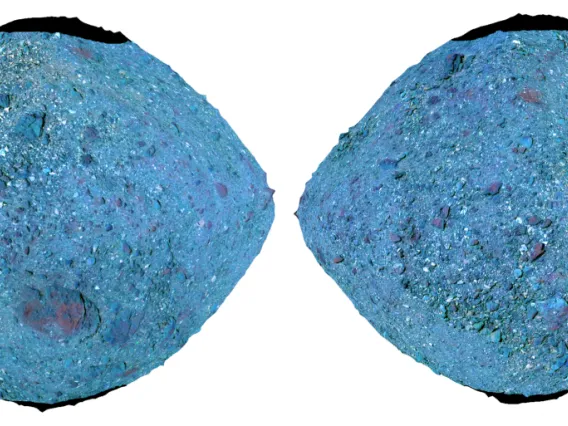
An Asteroid of a Different Color … and Other Secrets of Bennu Unlocked
The LPL-led OSIRIS-REx mission is gearing up for its first attempt to collect a sample from asteroid Bennu this month. But before even touching the surface, scientists are learning more than ever about the material that makes up the asteroid.
An Asteroid of a Different Color … and Other Secrets of Bennu Unlocked
×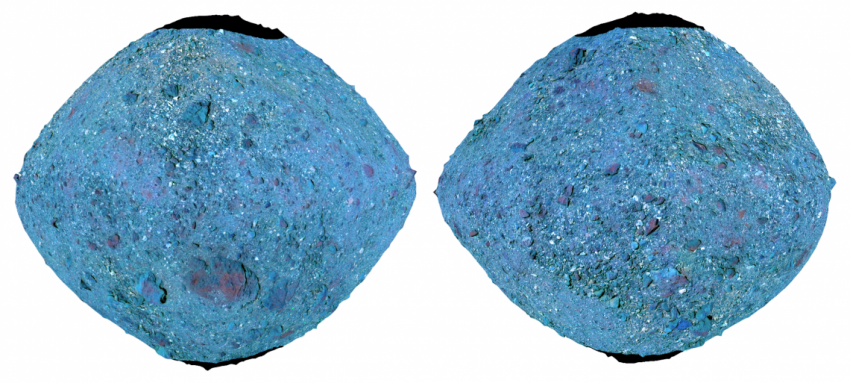
By University Communications and OSIRIS-REx - October 8, 2020
Scientists now know much more about the material NASA's first asteroid sample return mission will be collecting in just a few weeks.
In a special collection of six papers published today in the journals Science and Science Advances, scientists with the University of Arizona-led OSIRIS-REx mission present new findings on asteroid Bennu's surface material, geological characteristics and dynamic history. They also say that the sample delivered from Bennu may be unlike anything we have in the meteorite collection on Earth.
These discoveries complete the OSIRIS-REx mission's pre-sample collection science requirements and offer insight into an asteroid sample that scientists will study for generations to come.
Rocks in Rouge
One of the papers – published in Science and led by Dani DellaGiustina, lead scientist on the mission's image processing team and senior staff scientist at the UArizona Lunar and Planetary Laboratory – details a striking discovery at the mission's primary sample site, Nightingale, where OSIRIS-REx will make its first sample collection attempt on Oct. 20. The rocky debris covering the site has only recently been exposed to the harsh space environment. That means the mission will be collecting and returning some of the most pristine material on the asteroid.
Using spectroscopy – a technique that reveals a material's composition based on the pattern of reflected wavelengths of light – the scientists found that Nightingale is part of a population of young craters whose composition reflects mostly red light. Bennu's colors, as revealed through spectroscopy, are much more diverse than originally anticipated. This diversity results from a combination of different materials inherited from Bennu's parent body and different durations of exposure to the space environment.
While Bennu appears quite black to the naked eye, the authors illustrate the diversity of Bennu's surface by using false-color renderings of spectral data collected by the mission's MapCam camera. The freshest material on Bennu, such as that found at the Nightingale site, is spectrally redder than average and thus appears red in the images. Surface material turns vivid blue when it has been exposed to space weathering for an intermediate period of time. As the surface material continues to weather over long periods of time, it ultimately brightens across all wavelengths, becoming a less intense blue – the average spectral color of Bennu.
"When a material is exposed to the space environment, its surface weathers, but in a very different way than things do on Earth," DellaGiustina said. "In space, weathering is caused by exposure to solar wind and the rain of tiny micrometeorites. On the moon's surface and many asteroids, we have observed that space weathering darkens and reddens surfaces. On Bennu, however, the opposite is true. We see that over time Bennu has become brighter and bluer in response to space weathering. This is an exciting finding because it tells us that something about Bennu is quite different than other planetary surfaces we've observed."
The paper led by DellaGiustina also distinguishes two main types of boulders on Bennu's surface: dark and rough, and, less commonly, bright and smooth. The different types may have formed at different depths in the parent asteroid of Bennu.
A 'Scientific Triumph'
Another paper published in Science, led by Amy Simon from NASA's Goddard Space Flight Center in Greenbelt, Maryland, shows that carbon-bearing, organic material is widespread on the asteroid's surface, including at the Nightingale site. These findings indicate that hydrated minerals and organic material will likely be present in the collected sample.
This organic matter may contain carbon in a form often found in biology or in compounds associated with biology. Scientists are planning detailed experiments on these organic molecules and expect that the returned sample will help answer complex questions about the origins of water and life on Earth.
"The abundance of carbon-bearing material is a major scientific triumph for the mission. We are now optimistic that we will collect and return a sample with organic material – a central goal of the OSIRIS-REx mission," said Dante Lauretta, OSIRIS-REx principal investigator and UArizona planetary science professor, who co-authored all six papers in the collection.
History Hidden in Rocks
During fall 2019, NASA’s OSIRIS-REx spacecraft captured this image, which shows one of asteroid Bennu’s boulders with a bright vein that appears to be made of carbonate. The image within the circle (lower right) shows a focused view of the vein.NASA/Goddard/University of Arizona
Another study in the collection, published in Science and led by Hannah Kaplan from Goddard, found that carbonate minerals – which are compounds containing special combinations of carbon, oxygen and metals – make up some of the asteroid's geological features and might be present in the returned sample. Because these carbonate minerals form under certain conditions, scientists theorize that Bennu's parent asteroid likely hosted an environment where water interacted with and altered the rock on Bennu's parent body.
A Science Advances paper led by Ben Rozitis from The Open University in the U.K. shows that the dark boulders are weaker and more porous, whereas the bright boulders are stronger and less porous. However, both boulder types are weaker than scientists expected. Rozitis and colleagues suspect that Bennu's dark boulders – the weaker, more porous and more common type – would not survive the journey through Earth's atmosphere. It's therefore likely that the returned samples of asteroid Bennu will provide a missing link for scientists, as this type of material is not currently represented in meteorite collections.
A Surprising Shape
Bennu is a diamond-shaped pile of rubble floating in space, but there's more to it than meets the eye. Data obtained by the OSIRIS-REx Laser Altimeter, or OLA, has allowed the mission team to develop a 3D digital terrain model of the asteroid that, at nearly 8-inch resolution, is unprecedented in detail and accuracy.
In a Science Advances paper led by Michael Daly of York University, scientists explain how detailed analysis of the asteroid's shape revealed ridge-like mounds on Bennu that extend from pole-to-pole but are subtle enough that they could be easily missed by the human eye. Their presence has been hinted at before but only became clear when the northern and southern hemispheres were split apart in the OLA data for comparison.
The digital terrain model also shows that Bennu's northern and southern hemispheres have different shapes. The southern hemisphere appears to be smoother and rounder, which the scientists believe is a result of loose material getting trapped by the region's numerous large boulders.
What's at the Center of Bennu?
Another Science Advances paper in the special collection, led by Daniel Scheeres of University of Colorado Boulder, examines the gravity field of Bennu, which has been determined by tracking the trajectories of the OSIRIS-REx spacecraft and the particles that are naturally ejected from Bennu's surface.
The reconstructed gravity field shows that the interior of Bennu is not uniform. Instead, there are pockets of higher and lower density material inside the asteroid. It's as if there is a void at its center, within which you could fit a couple of football fields.
All six publications in the special collection use global and local datasets collected by the OSIRIS-REx spacecraft from February through October 2019. The special collection underscores that sample return missions like OSIRIS-REx are essential to fully understanding the history and evolution of the solar system.
The mission is less than two weeks away from fulfilling its biggest goal – collecting a piece of a pristine, hydrated, carbon-rich asteroid. OSIRIS-REx will depart Bennu in 2021 and deliver the sample to Earth on Sept. 24, 2023.
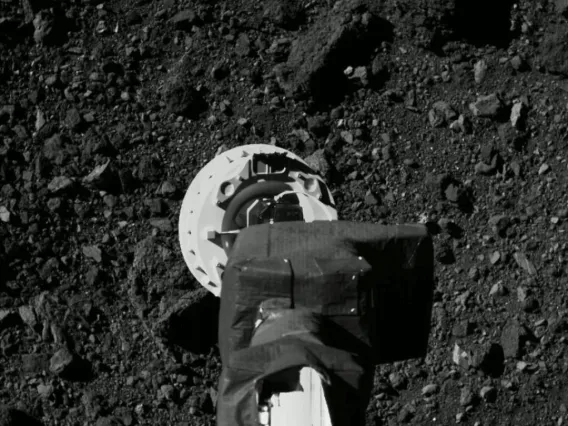
25 Days of 'O-REx'
There are T minus 25 days until the LPL-led NASA OSIRIS-REx mission attempts to collect its first-ever asteroid sample. Here are facts for each day of the countdown.
25 Days of 'O-REx'
×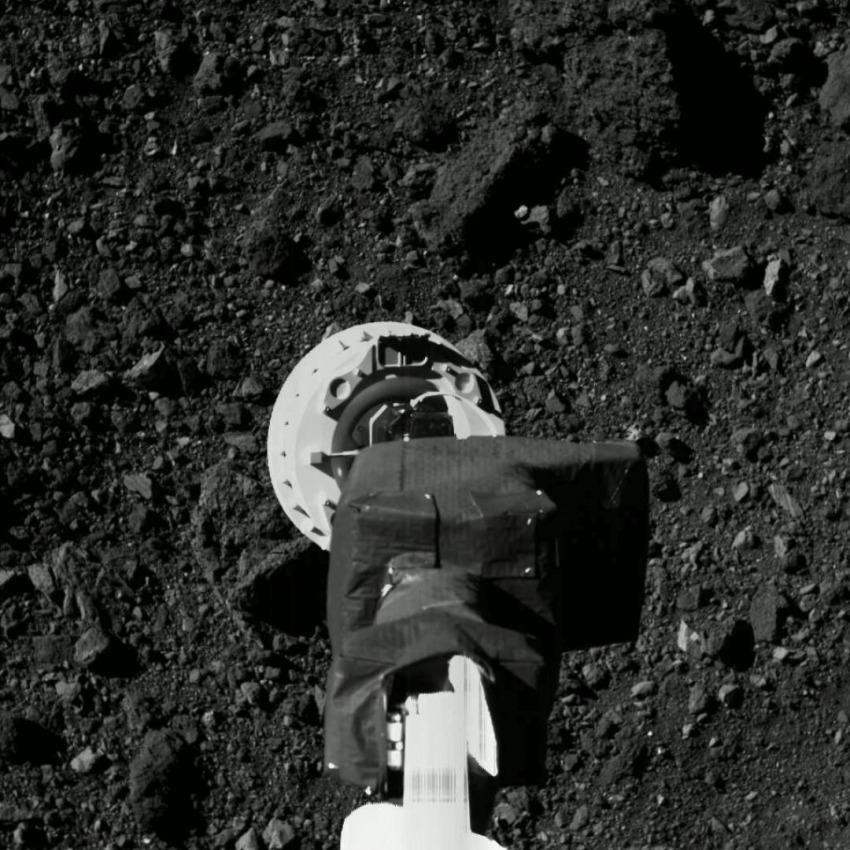
By Mikayla Mace, University of Arizona - September 25, 2020
The University of Arizona-led OSIRIS-REx mission is poised to accomplish a first for NASA in planetary science: collect a sample from a near-Earth asteroid and bring it back home. The composition of the asteroid Bennu could shed more light on the origins and evolution of the 4.5 billion-year-old solar system.
On Oct. 20, the spacecraft will begin a flight trajectory to descend to the asteroid’s surface. Then, it will extend a sample collection arm that will briefly touch the surface, fire a small puff of compressed nitrogen to kick up debris and capture it before storing it in the body of the spacecraft for safekeeping on the two-year journey home.
Sept. 26 marks 25 days until the Touch-And-Go, or TAG, sample collection event, after which the spacecraft will stow the sample for its return to Earth on Sept. 24. 2023.
To celebrate the historic moment, UANews is counting down the 25 Days of "O-REx" with 25 facts.
25. This mission is a first for NASA. Several NASA spacecraft have studied asteroids from a distance, but none have touched an asteroid and returned with material. The mission was designed to return at least 60 grams (slightly over 2 ounces) of pristine asteroid material to Earth for analysis.
24. This image shows sample site Nightingale Crater, OSIRIS-REx’s primary sample collection site on asteroid Bennu. The image is overlaid with a graphic of the OSIRIS-REx spacecraft to illustrate the scale of the site.NASA/Goddard/University of Arizona
While scientists had predicted the asteroid's shape with uncanny accuracy, the surface of Bennu was unexpectedly rocky. The mission team spent over 18 months extensively surveying the surface for a boulder-free area before identifying Nightingale as the primary sample collection site and Osprey as the backup sample site.
23. The primary sample site, Nightingale, is located in a crater in Bennu's northern hemisphere and was determined to be the safest spot for the Touch-And-Go sample collection maneuver. For scale, the spacecraft's brief touchdown will be like parking a shuttle van in an area about as wide as three parking spaces. The site is one-tenth as large as the original mission plan envisioned.
22. On the journey back to Earth, the spacecraft will eject its sample return capsule containing the bits of Bennu for landing in the Utah desert on Sept. 24, 2023. The entire trip from launch to landing will have spanned seven years and 4.4 billion miles of space travel.
21. The asteroid is a time capsule from the early solar system. Made from the crumbs of what was left over after the formation of the solar system, it is rich with organic compounds that may have seeded life on Earth.
20. Bennu is about the same size as Pusch Ridge in the Santa Catalina Mountains, measuring about 500 meters, or about one-third of a mile, in diameter.
19. The asteroid Bennu is a near-Earth asteroid – meaning it is not part of the main asteroid belt – and is situated between 241,000 and 209 million miles away, depending on its orbit relative to Earth's. Right now, the asteroid and spacecraft are about 200 million miles from Earth.
18. Bennu is in an unstable orbit, meaning it likely won't last more than 10 million years before it collides with a planet or falls into the sun.
17. Evidence of water was discovered locked within the clays that make up the asteroid. While Bennu itself is too small to have ever hosted liquid water, liquid water was likely present at some time on Bennu's parent body, a much larger asteroid.
16. Bennu's temperatures range from 240 degrees Fahrenheit during the day to 100 below zero at night.
15. The mission marked a milestone recognized by the Guinness World Records. The spacecraft made the closest orbit of a planetary body and made the asteroid the smallest planetary object ever orbited by a spacecraft.
14. Bennu is shedding. It regularly ejects particles from its surface, highlighting just how dynamic the miniature world can be.
13. This global map of asteroid Bennu’s surface was created by stitching and correcting 2,155 PolyCam images. At 2 inches (5 cm) per pixel, this is the highest resolution at which a planetary body has been globally mapped.NASA/Goddard/University of Arizona.
The OSIRIS-REx mission's science team, headquartered at UArizona, created the most detailed image of any body in the solar system with its global mosaic of the asteroid Bennu. The mosaic was created by stitching together 2,155 images at a scale of 2 inches per pixel. The map was used to choose the primary and secondary sample sites.
12. When the spacecraft touches down for sampling, it will do so on autopilot due to the 18.5-minute time delay between Earth and the spacecraft.
11. The UArizona-built PolyCam is so named because it is a master of all trades and the world's best zoom lens – it can be a microscope and a telescope, and anything in between. It captured OSIRIS-REx's first image of the asteroid, helped with mapping large boulders and rocks and is expected to microscopically scrutinize tiny rocks and pebbles on the surface to ensure that they are small enough for sample collection.
10. UArizona also built the two other on-board cameras – MapCam, which was used to map the surface of the asteroid, and SamCam, which will record the entire sample collection event and verify that a sample was collected.
9. During its descent to site Nightingale, OSIRIS-REx could encounter several hazardous scenarios that would prevent it from collecting a sample of asteroid Bennu on its first attempt.NASA/Goddard/CI Lab
The spacecraft can navigate the asteroid using what's called natural feature tracking. By comparing the surface features found within the high-resolution image catalog with the surface, the spacecraft can autonomously guide itself to the surface for sample collection.
8. O-REx will perform a pirouette in space to weigh how much material was collected during the Touch-and-Go sample collection event.
7. While flying through space, the OSIRIS-REx spacecraft navigates using the stars, similar to ocean-going explorers.
6. Bits of the asteroid Vesta were recently found on Bennu.
5. A total of 150 UArizona undergraduate and graduate students have worked on OSIRIS-REx. More than 30 alumni have been hired to join the mission as staff after graduating.
4. The mission's economic impact on Arizona is around $230.5 million. Of that, approximately $173 million comes to Tucson.
3. UArizona professor Dante Lauretta is the principal investigator of the OSIRIS-REx mission, a $1 billion project led by the University of Arizona. The mission's science operations command center is at the UArizona Lunar and Planetary Laboratory.
2. OSIRIS-REx builds on the university's long legacy of successful planetary exploration. The university has been part of almost every major NASA planetary mission since they began. The most recent NASA missions include HiRISE (Alfred McEwen, principal investigator), Dawn Mission (Mark Sykes, co-investigator, and Shane Byrne, guest investigator); Juno Mission (William Hubbard, co-investigator); and the New Horizons Mission to Pluto (Veronica Bray, science team member). UArizona was the first public university to be awarded a principal investigator-led mission when it was chosen to lead the Phoenix Mars mission.
1. The mission is officially named the Origins, Spectral Interpretation, Resource Identification, Security-Regolith Explorer. Osiris is the Egyptian god of the underworld and "rex" means king in Latin. The mission objectives to return asteroid samples and analyze them in lab around the world loosely matches the mythological story of Osiris, whose body was cut into pieces and sprinkled all over Egypt, marking the spread of agriculture.
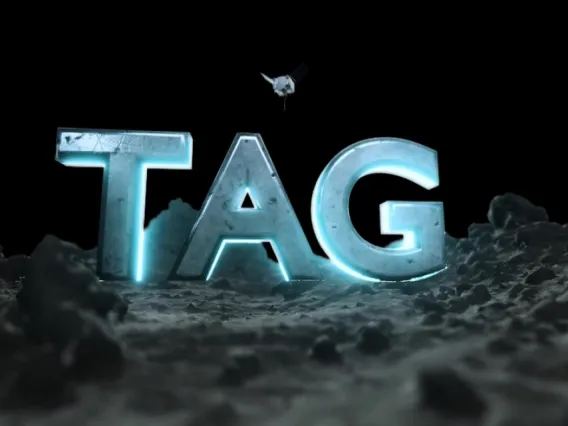
OSIRIS-REx Begins its Countdown to TAG
On Oct. 20, the LPL-led OSIRIS-REx mission will make its first sample collection attempt. Because of the communication delay, the spacecraft must pilot itself to the surface while avoiding hazardous boulders before backing away safely with the sample.
OSIRIS-REx Begins its Countdown to TAG
×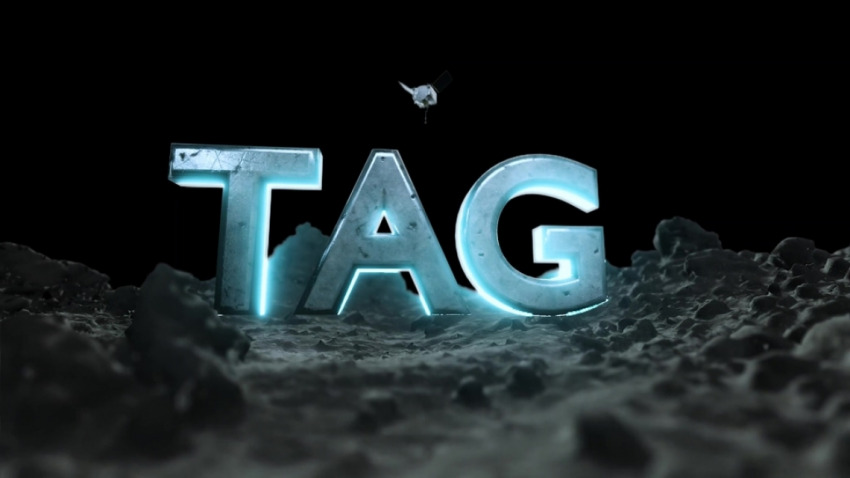
By Brittany Enos, OSIRIS-REx - September 24, 2020
A historic moment is on the horizon for the University of Arizona-led NASA OSIRIS-REx mission. In just a few weeks, the robotic OSIRIS-REx spacecraft will descend to asteroid Bennu's boulder-strewn surface, touch down for a few seconds and collect a sample of the asteroid's rocks and dust – marking the first time NASA has grabbed pieces of an asteroid, which will be returned to Earth for study.
"This is all about understanding our origins and addressing some of the most fundamental questions that we ask ourselves as human beings: Where did we come from and are we alone in the universe?" Dante Lauretta, OSIRIS-REx principal investigator at the UArizona Lunar and Planetary Laboratory, said during a media event Thursday.
The university leads the science team and the mission's science observation planning and data processing.
The science team chose the dark, low-reflectance asteroid Bennu early in the mission design because it is likely full of the organic material and hydrated minerals that could have led to water on Earth.
"That information was based on a technique called spectroscopy. One aspect of the OSIRIS-REx science program is to understand these dark, low-reflectance asteroids and try to infer composition from that information," Lauretta said. "There are over 1 million asteroids in the solar system, so we're not going to send spacecraft to every one of those. …We're going to use the spectra and OSIRIS-REx samples to better understand the spectra of these objects."
Touch-And-Go
On Oct. 20, the mission will perform the first attempt of its Touch-And-Go, or TAG, sample collection event. This series of maneuvers will bring the spacecraft down to a site named Nightingale, a rocky area 52 feet in diameter in Bennu's northern hemisphere, where the spacecraft's robotic sampling arm will attempt to collect a sample. Nightingale was selected as the mission's primary sample site because it holds the greatest amount of unobstructed fine-grained material, but the region is surrounded by building-sized boulders. During the sampling event, the spacecraft, which is the size of a large van, will attempt to touch down in an area that is only the size of a few parking spaces and just a few steps away from some of these large boulders.
During the 4 1/2-hour sample collection event, the spacecraft will perform three separate maneuvers to reach the asteroid's surface. The descent sequence begins with OSIRIS-REx firing its thrusters for an orbit departure maneuver to leave its safe-home orbit approximately 2,500 feet from Bennu's surface. After traveling four hours on this downward trajectory, the spacecraft performs the "checkpoint" maneuver at an approximate altitude of 410 feet. This thruster burn adjusts OSIRIS-REx's position and speed to descend steeply toward the surface. About 11 minutes later, the spacecraft performs the "matchpoint" burn at an approximate altitude of 177 feet, slowing its descent and targeting a path to match the asteroid's rotation at the time of contact. The spacecraft then descends to the surface, touches down for less than 16 seconds and fires one of its three pressurized nitrogen bottles. The gas agitates and lifts Bennu's surface material, which is then caught in the spacecraft's collector head. After this brief touch, OSIRIS-REx fires its thrusters to back away from Bennu's surface and navigates to a safe distance from the asteroid.
After the orbit departure maneuver, the spacecraft undertakes a sequence of reconfigurations to prepare for sampling. First, OSIRIS-REx extends its robotic sampling arm – the Touch-And-Go Sample Acquisition Mechanism, or TAGSAM – from its folded storage position out to the sample collection position. The spacecraft's two solar panels then move into a "Y-wing" configuration over the spacecraft's body, which positions them safely up and away from the asteroid's surface during touchdown. This configuration also places the spacecraft's center of gravity directly over the TAGSAM collector head, which is the only part of the spacecraft that will contact Bennu's surface during the sample collection event.
Because the spacecraft and Bennu are approximately 207 million miles from Earth during TAG, it will take about 18 1/2 minutes for signals to travel between them. This time lag prevents the live commanding of flight activities from the ground during the TAG event, so the spacecraft is designed to perform the entire sample collection sequence autonomously. Prior to the event's start, the OSIRIS-REx team will uplink all of the commands to the spacecraft and then send a "go" command to begin.
To autonomously navigate to Nightingale, OSIRIS-REx uses the natural feature tracking navigation system. The spacecraft begins collecting navigation images about 90 minutes after orbit departure. It then compares these real-time images to an onboard image catalog, using identified surface features to make sure that it's on the right course toward the site. As the spacecraft approaches the surface, OSIRIS-REx updates the checkpoint and matchpoint maneuvers based on the navigation system's estimate of the spacecraft's position and velocity. OSIRIS-REx continues to use the system estimates as it descends to the surface after the matchpoint maneuver to monitor its position and descent rate. The spacecraft will autonomously abort should its trajectory vary outside of predefined limits.
To ensure that the spacecraft touches down on a safe area that avoids the region's many boulders, the navigation system is equipped with a hazard map of site Nightingale, which delineates areas within the sample site that could potentially harm the spacecraft. If the spacecraft's navigation system detects that it is on course to touch one of these hazardous zones, the spacecraft will autonomously wave off its approach once it reaches an altitude of 16 feet. This keeps the spacecraft safe and allows for a subsequent sample collection attempt at a future date.
As the spacecraft performs each event in the sample collection sequence, it will send telemetry updates back to the OSIRIS-REx team, albeit at an extremely slow data rate. The team will monitor the telemetry during the excursion and will be able to confirm that the spacecraft has successfully touched down on Bennu's surface soon after TAG occurs. The images and other science data collected during the event will be downlinked after the spacecraft has backed away from the asteroid and can point its larger antenna back to Earth to transmit at higher communication rates.
OSIRIS-REx is charged with collecting at least 2 ounces of Bennu's rocky material to deliver back to Earth – the largest sample return from space since the Apollo program – and the mission developed two methods to verify that this sample collection occurred. On Oct. 22, OSIRIS-REx's SamCam camera will capture images of the TAGSAM head to see whether it contains Bennu's surface material. The spacecraft will also perform a spin maneuver on Oct. 24 to determine the mass of collected material. If these measures show successful collection, the decision will be made to place the sample in the sample return capsule for return to Earth. If sufficient sample has not been collected from Nightingale, the spacecraft has onboard nitrogen charges for two more attempts. A TAG attempt at the backup site, Osprey, would be made no earlier than January 2021.
"On the day of TAG, Oct. 20, we will have slow data rate coming in. The spacecraft will be talking to us at 40 bits per second, so we're not getting a lot of information about how much sample we collected," Lauretta said. "Over the next week or so, we will do series of activities to understand how the TAG event worked and do as much as we can to verify that we collect our minimum of 60 grams – 2 ounces – of sample or more."
The team will start by looking at images snapped of the sample head itself and recordings of the sample collection process.
"We'll be able to tell if we were tilted, if the gas blew out to the side or if material was significantly mobilized. We'll also have good indication of the exact location in Nightingale where we made contact, and we can compare it to the samplability map to indicate if we landed in an area with abundant sample material or in one of the more rocky locations with larger fragments," Lauretta said. "I'm confident that we'll have abundant material based on the nature of the Nightingale site and the extensive testing we did with our TAGSAM."
The mission team has spent the last several months preparing for the sample collection event while maximizing remote work as part of its COVID-19 response. On the day of TAG, a limited number of team members will monitor the spacecraft from Lockheed Martin Space's Mission Support Area, taking appropriate safety precautions. Other members of the team will be at other locations on-site to cover the event, while also observing safety protocols.
The spacecraft is scheduled to depart Bennu in 2021 and deliver the collected sample to Earth on Sept. 24, 2023.
NASA's Goddard Space Flight Center in Greenbelt, Maryland, provides overall mission management, systems engineering, and the safety and mission assurance for OSIRIS-REx. Lockheed Martin Space in Denver built the spacecraft and provides flight operations. Goddard and KinetX Aerospace are responsible for navigating the OSIRIS-REx spacecraft. OSIRIS-REx is the third mission in NASA's New Frontiers program, which is managed by NASA's Marshall Space Flight Center in Huntsville, Alabama, for the agency's Science Mission Directorate in Washington.
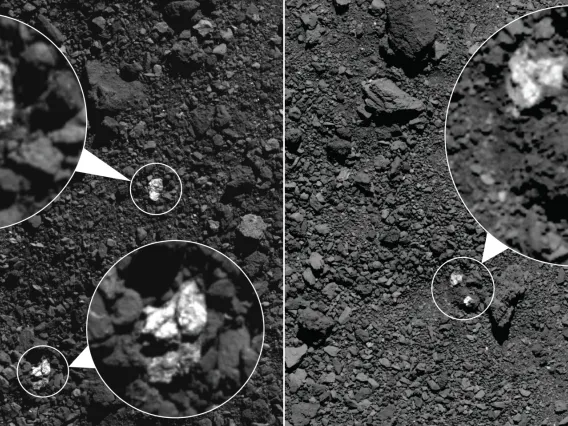
NASA's OSIRIS-REx to Asteroid Bennu: 'You've Got a Little Vesta on You...'
Bits of the asteroid Vesta found on Bennu highlight the variety of asteroids in the solar system.
NASA's OSIRIS-REx to Asteroid Bennu: 'You've Got a Little Vesta on You...'
×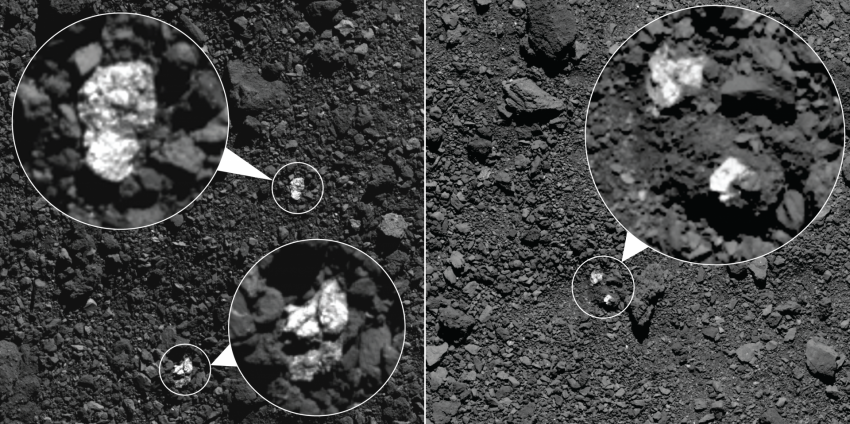
By NASA Goddard Space Flight Center and University Communications - September 21, 2020
In an interplanetary faux pas, it appears some pieces of asteroid Vesta ended up on asteroid Bennu, according to observations from the University of Arizona-led OSIRIS-REx mission. The new result sheds light on the intricate orbital dance of asteroids and on the violent origin of Bennu, which is a "rubble pile" asteroid that coalesced from the fragments of a massive collision.
"We found six boulders ranging in size from 5 to 14 feet (about 1.5 to 4.3 meters) scattered across Bennu's southern hemisphere and near the equator," said Daniella DellaGiustina, the NASA mission's image processing lead scientist and senior staff scientist at the university's Lunar and Planetary Laboratory. "These boulders are much brighter than the rest of Bennu and match material from Vesta."
"Our leading hypothesis is that Bennu inherited this material from its parent asteroid after a vestoid (a fragment from Vesta) struck the parent," said Hannah Kaplan of NASA's Goddard Space Flight Center in Greenbelt, Maryland. "Then, when the parent asteroid was catastrophically disrupted, a portion of its debris accumulated under its own gravity into Bennu, including some of the pyroxene from Vesta."
DellaGiustina and Kaplan are primary authors of a paper on this research, published in Nature Astronomy.
The unusual boulders on Bennu first caught the team's eye in images from the OSIRIS-REx Camera Suite, or OCAMS. They appeared extremely bright, with some almost 10 times brighter than their surroundings. They analyzed the light from the boulders using the OSIRIS-REx Visible and Infrared Spectrometer, or OVIRS, instrument to get clues to their composition. A spectrometer separates light into its component colors. Since elements and compounds have distinct, signature patterns of bright and dark across a range of colors, they can be identified using a spectrometer. The signature from the boulders was characteristic of the mineral pyroxene, similar to what is seen on Vesta and the vestoids – smaller asteroids that are fragments blasted from Vesta when it sustained significant asteroid impacts.
Of course, it's possible that the boulders actually formed on Bennu's parent asteroid, but the team thinks this is unlikely based on how pyroxene typically forms. The mineral typically forms when rocky material melts at high temperature. However, most of Bennu is composed of rocks containing water-bearing minerals, so it – and its parent – couldn't have experienced very high temperatures. Next, the team considered localized heating, perhaps from an impact. An impact needed to melt enough material to create large pyroxene boulders would be so significant that it would have destroyed Bennu's parent-body. So, the team ruled out these scenarios, and instead considered other pyroxene-rich asteroids that might have implanted this material to Bennu or its parent.
Observations reveal it's not unusual for an asteroid to have material from another asteroid splashed across its surface. Examples include dark material on crater walls seen by the Dawn spacecraft at Vesta, a black boulder seen by the Hayabusa spacecraft on Itokawa and, very recently, material from S-type asteroids observed by Hayabusa2 at Ryugu. This indicates many asteroids are participating in a complex orbital dance that sometimes results in cosmic mashups.
As asteroids move through the solar system, their orbits can be altered in many ways, including the pull of gravity from planets and other objects, meteoroid impacts and even the slight pressure from sunlight. The new result helps pin down the complex journey Bennu and other asteroids have traced through the solar system.
Several studies indicate that Bennu, based on its orbit, was delivered from the inner region of the main asteroid belt via a well-known gravitational pathway that can take objects from the inner main belt to near-Earth orbits. There are two inner main belt asteroid families – Polana and Eulalia – that look like Bennu: dark and rich in carbon, making them likely candidates for Bennu's parent. Likewise, the formation of the vestoids is tied to the formation of the Veneneia and Rheasilvia impact basins on Vesta, at roughly about two billion years ago and approximately one billion years ago, respectively.
"Future studies of asteroid families, as well as the origin of Bennu, must reconcile the presence of Vesta-like material, as well as the apparent lack of other asteroid types. We look forward to the returned sample, which hopefully contains pieces of these intriguing rock types," said Dante Lauretta, OSIRIS-REx principal investigator and UArizona professor of planetary science and cosmochemistry. "This constraint is even more compelling given the finding of S-type material on asteroid Ryugu. This difference shows the value in studying multiple asteroids across the solar system."
The OSIRIS-REx spacecraft will make its first attempt to collect a sample from Bennu in October and will return it to Earth in 2023 for detailed analysis. The mission team closely examined four potential sample sites on Bennu to determine their safety and science value before making a final selection in December 2019. DellaGiustina and Kaplan's team thinks they might find smaller pieces of Vesta in images from these close-up studies.
The research was funded by the NASA New Frontiers Program. The primary authors acknowledge significant collaboration with the French space agency CNES and Japan Society for the Promotion of Science Core-to-core Program on this paper. NASA's Goddard Space Flight Center in Greenbelt, Maryland, provides overall mission management, systems engineering, and the safety and mission assurance for OSIRIS-REx. Lauretta is the principal investigator, and the University of Arizona also leads the science team and the mission's science observation planning and data processing. The late Michael Drake of UArizona pioneered the study of vestoid meteorites and was the first principal investigator for OSIRIS-REx. Lockheed Martin Space in Denver built the spacecraft and is providing flight operations. Goddard and KinetX Aerospace are responsible for navigating the OSIRIS-REx spacecraft. OSIRIS-REx is the third mission in NASA's New Frontiers Program, which is managed by NASA's Marshall Space Flight Center in Huntsville, Alabama, for the agency's Science Mission Directorate in Washington, D.C.
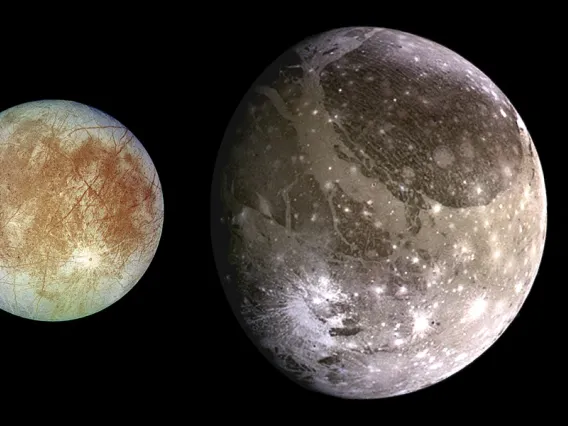
Jupiter's Moons Could be Warming Each Other
The gravitational push and pull by Jupiter's moons could account for more warming than the gas giant Jupiter alone.
Jupiter's Moons Could be Warming Each Other
×
By Mikayla Mace, University Communications - September 10, 2020
Jupiter's moons are hot.
Well, hotter than they should be, for being so far from the sun. In a process called tidal heating, gravitational tugs from Jupiter's moons and the planet itself stretch and squish the moons enough to warm them. As a result, some of the icy moons contain interiors warm enough to host oceans of liquid water, and in the case of the rocky moon Io, tidal heating melts rock into magma.
Researchers previously believed that the gas giant Jupiter was responsible for most of the tidal heating associated with the liquid interiors of the moons, but a new study published in Geophysical Research Letters found that moon-moon interactions may be more responsible for the heating than Jupiter alone.
"It's surprising because the moons are so much smaller than Jupiter. You wouldn't expect them to be able to create such a large tidal response," said the paper's lead author Hamish Hay, a postdoctoral fellow at the Jet Propulsion Laboratory in Pasadena, California, who did the research when he was a graduate student in the University of Arizona Lunar and Planetary Laboratory.
Understanding how the moons influence each other is important because it can shed light on the evolution of the moon system as a whole. Jupiter has nearly 80 moons, the four largest of which are Io, Europa, Ganymede and Callisto.
"Maintaining subsurface oceans against freezing over geological times requires a fine balance between internal heating and heat loss, and yet we have several pieces of evidence that Europa, Ganymede, Callisto and other moons should be ocean worlds," said co-author Antony Trinh, a postdoctoral research fellow in the Lunar and Planetary Lab. "Io, the Galilean moon closest to Jupiter, shows widespread volcanic activity, another consequence of tidal heating, but at a higher intensity likely experienced by other terrestrial planets, like Earth, in their early history. Ultimately, we want to understand the source of all this heat, both for its influence on the evolution and habitability of the many worlds across the solar system and beyond."
Tidal Resonance
The trick to tidal heating is a phenomenon called tidal resonance.
"Resonance creates loads more heating," Hay said. "Basically, if you push any object or system and let go, it will wobble at its own natural frequency. If you keep on pushing the system at the right frequency, those oscillations get bigger and bigger, just like when you're pushing a swing. If you push the swing at the right time, it goes higher, but get the timing wrong and the swing's motion is dampened."
Each moon's natural frequency depends on the depth of its ocean.
"These tidal resonances were known before this work, but only known for tides due to Jupiter, which can only create this resonance effect if the ocean is really thin (less than 300 meters or under 1,000 feet), which is unlikely," Hay said. "When tidal forces act on a global ocean, it creates a tidal wave on the surface that ends up propagating around the equator with a certain frequency, or period."
According to the researchers' model, Jupiter's influence alone can't create tides with the right frequency to resonate with the moons because the moons' oceans are thought to be too thick. It's only when the researchers added in the gravitational influence of the other moons that they started to see tidal forces approaching the natural frequencies of the moons.
When the tides generated by other objects in Jupiter's moon system match each moon's own resonant frequency, the moon begins to experience more heating than that due to tides raised by Jupiter alone, and in the most extreme cases, this could result in the melting of ice or rock internally.
For moons to experience tidal resonance, their oceans must be tens to hundreds of kilometers – at most a few hundred miles – thick, which is in range of scientists' current estimates. However, there are some caveats to the researchers' findings.
Their model assumes that tidal resonances never get too extreme, Hay said. He and his team want to return to this variable in the model and see what happens when they lift that constraint.
Hay also is hoping that future studies will be able to infer the true depth of the oceans within these moons.
This study was funded by NASA's Habitable Worlds program.
